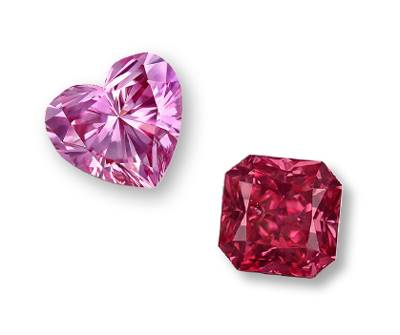 For any collector of luxury goods, few things matter more than a guarantee that you’re getting what you pay for.
For any collector of luxury goods, few things matter more than a guarantee that you’re getting what you pay for.
Whether it’s fine art, vintage automobiles, or in this case – diamonds – all collectors seek an assurance that the item being purchased is as advertised.
Equal parts rare and remarkable, fancy colour pink diamonds, particularly those originating from Australia’s Kimberley region, continue to be among the world’s most exceptional and valuable diamonds.
Pink diamonds have been unearthed in many major diamond-producing regions, including Brazil, Russia, Canada, and a range of African nations, including Tanzania, South Africa, Botswana, Angola, and of course, Australia.
Naturally, no two pink diamonds are the same, and those extracted from the Argyle mine in Western Australia stand alone in terms of quality – and as a result, collectors are increasingly demanding confirmation of this quality via certification.
John Chapman is the director of Delta Diamond Laboratory and has dedicated much of his life to developing a largely unrivalled understanding of the characteristics of Argyle pink diamonds.
With nearly four decades of experience in the industry, including multiple PhD studies on Argyle pink diamonds with the Universities in Western Australia, Melbourne and the UK, Chapman says that there’s still much to learn.
“The Argyle deposit is somewhat unique in its geological history.
“The diamonds within seem to have experienced a hotter life in the depths of the earth resulting in migration and clustering of impurity atoms within the diamond,” Chapman tells Jeweller.
“Most importantly”, he adds, “the regular diamond structure has suffered forces that have distorted the lattice and generated unique atomic defect structures that give rise to pink.
“However the precise nature of the structure remains a mystery despite much university research.”
Chapman continues: “Pinks are found in other locations too, but they have a different concentration of the most common impurity - nitrogen and other trace impurities that tend to give rise to a slightly purplier or orangey hue.”
Problem
For the collectors of pink diamonds, the issue of provenance and certification weighs heavily on the minds of collectors.
With such an important demarcation existing between Argyle pink diamonds and the remainder of the world’s supply, certification and provenance become increasingly important concepts.
A recent opinion article in Jeweller by William Gant, LJ West Diamonds Australia managing director, stressed that evidence of origin is crucial for the trade.
“Provenance has become a crucial factor for collectors of the legendary Argyle pink and violet diamonds,” he says.
“If 90 per cent of the world’s pink diamonds have been discovered in Western Australia, it’s important that the other stones are not passed off as Argyle pinks.
“Unfortunately certificates from independent labs typically do not state the origin of the stone. It comes as no surprise then that many collectors of Argyle pinks and violets will demand certificates issued by the mine itself, to prove beyond doubt that the stones originated from the Argyle deposit.”
Rio Tinto has been issuing certificates with pink diamonds since the early days of the mine, however, the size and quality of diamond that qualifies for a certificate has changed over time.
Therefore, many Argyle pink diamonds were never issued a certificate, and in some instances, documentation has been lost over time – not an issue unique to Argyle pink diamonds, but an issue nonetheless.
It wasn’t until 2005 that Argyle Mine diamonds began to be laser inscripted. That certification was limited to diamonds weighing 0.2 carats and above, and it wasn’t until more than a decade later – within a handful of years of the mine closing – that smaller diamonds and 10-pointers began to receive certification.
This limitation of the mine’s certification presents a major thorn in the side of collectors.
“This means that the vast majority of pink and violet diamonds from the Argyle deposit – including from the peak of the mine’s production around the turn of the millennium, when Argyle produced fully a third of the world’s diamonds – are not certified with inscriptions to link them,” Gant explains.
“This restricts some collectors, focused on acquiring Argyle certifed pinks and violets, from getting the chance to own them, as supply is so limited.
“Fortunately, laboratory analyses have become increasingly sophisticated, enough to be able to verify the origin of a diamond in some instances.”
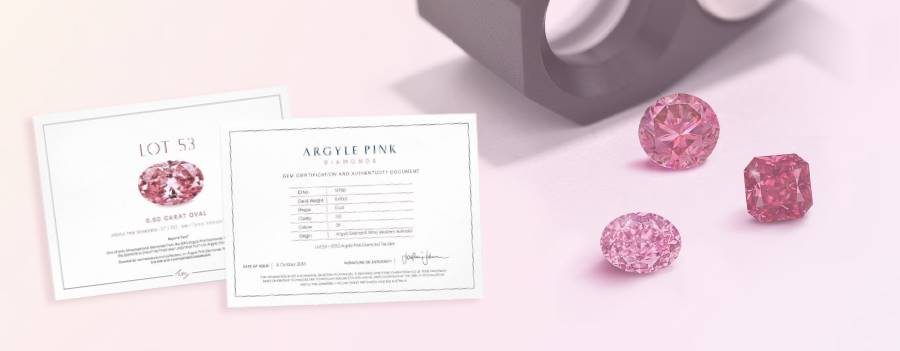
Solution
Laboratories today are able to create a geological identity for a diamond by measuring characteristics such as atomic impurity and temperature conditioning.
The detailed optical and spectroscopic analysis compares one pink diamond with the identity of others known to have originated from the Argyle mine and other desposits, and certification is thus achievable.
Chapman is responsible for his laboratory, based in Perth, and his lab records multiple properties using ultra-violet, infra-red light and lasers.
The interactions produce signatures that are presented in the Delta certificate. Certificates also include photos of the fluorescence and spectra. Impurities caused by nitrogen impart nuances to the spectra and optical behaviour, leading to the identification of pinks from the Argyle mine.
Chapman says the desire for detailed provenance information from collectors has continued to drive the science.
“Education and online transactions have perhaps resulted in a greater emphasis on certificates,” he explains.
“Consumers are more familiar with the 4Cs but rely on certificates to give them the grade of a diamond. Without certificates, a transaction would have to happen in person and most consumers would be uncomfortable making a call on colour or clarity. Delta doesn’t certify colour or clarity, yet, as most diamonds have GIA reports that are more recognised.
“My experience hasn’t had much direct experience with consumers, so I can only comment as a bystander. I’ve observed that there seems to be a greater emphasis on the certificate paper that accompanies a diamond and that consumers are regarding their purchase more under the lens of an investor.
“Purchases of pink diamonds seem to be less about making a nice piece of jewellery and more about storing
it away in the hopes of making a profit later.”
Unique fingerprint
Another Australian scientist has played a key role in the evolution of the science behind diamond certification – Professor John Watling.
An expert in forensic and analytic chemistry, Watling says that laser technology can be used to generate a unique fingerprint from a pink diamond. This fingerprint reveals which section of kimberlite pipe the diamond originated from, allowing Argle pink diamonds to separate from diamonds found elsewhere.
"Think of it as inorganic DNA, if you like," Watling tells ABC News.
"Because there is no such thing as, obviously, DNA in non-life form. This is the equivalent of that.
"The original start of this was a technique called gold fingerprinting.
"In 1974, I got involved with some police work when a 747 — that was transporting boxes of lead to America from South Africa to make lead toys — had an engine problem and landed in Heathrow Airport, and they unloaded it. They cut one of these lead ingots in half and the core was gold.”
Watling has worked at both Curtin University and the University of Western Australia and his provenance technology is now being used not only determine the origins of diamonds and gold, but also food products too.

Wind back the clock
Pink diamonds were first discovered in India at mines within the legendary Golconda kingdom.
It’s from this region that the Darya-i-Noor originates, the largest pink diamond in the world, polished at 186 carats from the Kollur Mine. The diamond is currently part of the Iranian crown jewels in Tehran.
Pink diamonds were discovered in Brazil in the 17th century, with Russia and a host of African nations soon becoming sourced for fancy colour diamonds as mining capabilities expanded over time.
The output from these locations, however, would pale in comparison to that of the Argyle Mine in the Kimberly region of Western Australia.
Patrick Coppens, general manager sales and marketing at Rio Tinto Diamonds, tells Jeweller that while the science behind the gemstones continues to evolve and improve, Argyle pinks are consistently recognisable.
“The Argyle Diamond Mine, over its 38-year history has produced virtually the world’s entire source of rare pink diamonds,” he explains.
“Whilst there has been sporadic production of pink diamonds from other parts of the world, never before and never since, has there been a diamond mine that consistently produced rare pink diamonds like the Argyle diamond mine.
“The depth and range of colour of Argyle pink diamonds is very unique and easily recognisable by diamantaires around the world. From a certifiable source, this very small but consistent volume of rare diamonds has a range of colours including reds, blues and violets along with pink diamonds in every shade on that spectrum.”
The Argyle diamond mine is located in the Kimberley region in the far northeast of WA, found to the south-west of Lake Argyle in the Matsu Ranges, around 550 kilometres south-west of Darwin.
The region became of interest for miners in the late 19th century, as gold prospectors uncovered deposits of diamonds.
The mine wouldn’t be officially commissioned until December of 1985, reaching peak production in 1994 with 42 million carats unearthed. The open pit mine produced more than 750 million carats in total.
While just 5 per cent of the mined diamonds were of gem quality – down compared to the 20 per cent worldwide average – the best were unmatched.
The international jewellery community took great notice as fancy colour red, purple, and pink diamonds were unearthed bearing unrivalled quality. 90 per cent of the world’s supply of pink diamonds would originate from WA.
With the closure of the Argyle Mine in 2020, LJ West’s Gant says the market’s thirst for pink diamonds is easy to understand.
“Argyle-certified stones are becoming scarcer by the day with the mine no longer in production,” Gant says.
“Demand continues to be intense. The value of pinks and violets have grown; with limited supply and high demand, it is a simple economic reality.
“Most consumers want an Argyle pink, and they want to be sure they get what they paid for.”
Diamond provenance became a hot topic in the 1990s and early 2000s, as consumers became increasingly aware of the existence of “blood diamonds” – gemstones stemming from sources of conflict or war, with which the proceeds may be used to fuel violence or support organisations responsible for violence.
Provenance soon began to play a key role in the diamond and gemstone industries, both as an assurance that a product was “sourced responsibly” and also as a powerful marketing tool to reinforce beliefs surrounding quality.
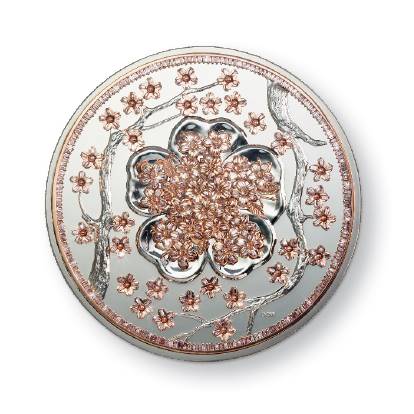 |  | 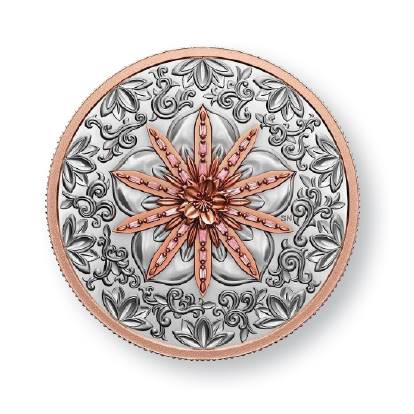 | Ultimate Opulence
Coins from the Opulence coin collection from the Royal Canadian Mint x Kunming. All coins feature Argyle pink diamonds. |
| 'The Ultimate' | 'Splendour' | 'Grandeur' | |
What’s the difference?
It’s easy to understand why fancy colour pink diamonds are beloved by collectors worldwide – as is the case with a wide range of gemstones, the item itself is an intricate thing of beauty, formed over millions of years under pressure and heat.
While scientists are still attempting to understand which factors specifically lead to the pink colour, it’s believed that high-pressure graining is a sign of a deeply compressed internal structure, resulting in the colour.
What is it, however, that separates Argle pink diamonds from those discovered in Africa, Russia or South America?
The 4Cs – colour, clarity, cut, carat – are the most familiar to the typical diamond consumer.
The quality of colour observed in pink diamonds mined from the Argyle Mine far exceeds that of pink diamonds mined elsewhere.
Specifically, Argyle pinks have a distinct tone with clear red, purple and blue influences, while other pink diamonds are usually said to have a muted colour more reminiscent of bubblegum.
Rio Tinto’s Coppens says Argyle pink diamonds are an authentic “one-off”.
“Acquiring an Argyle pink diamond is about incomparability with their allure and perpetual value similar to an art collector’s attitude,” he says.
“Their rarity, vibrancy of colour, natural beauty, rich provenance, and historical importance is the hallmark of an Argyle pink diamond.
“Today’s luxury world makes so many claims to ‘rare’. Luxury goods, many produced in multiples, and original only through customisation of monograms, are deemed ‘one-offs’.
“Argyle Pink Diamonds, in contrast, are truly rare.”
Coppens continues by explaining that the global supply of pink diamonds is limited by the circumstances of the moment of their creation – more than two billion years ago.
“Once unearthed, each Argyle pink diamond over eight points was authenticated with documentation and a unique lot number laser inscribed on the gem, visible only under magnification.
“The inscription and documentation represent an important guarantee regarding the chain of custody from the Argyle diamond mine to the point of purchase, providing assurance that the gem has always been in the care of Argyle pink diamonds and its trusted trade partners.”
Philosophical conundrum
Armed with an understanding of what separates Australia’s pink diamonds from the rest of the world, an interesting conundrum is created.
If it were possible to have two identical pink diamonds – one from the Argyle deposit and one from, say, Africa – would there be a difference in value between the two diamonds? Chapman says, “Strangely enough – yes.”
“The price difference would be quite significant, which shows the power of a brand. Rubies and sapphires also enjoy premium if they come from Burma (Myanmar) in the case of rubies, or Ceylon (Sri Lanka) in the case of sapphires.
“Yet there are other countries that produce equal quality rubies and sapphires that can be bought at half the price.
“This is more of a marketing question, however, my interpretation is consumers over the years have valued knowing the origins of their purchases.
"Combined with the marketing that has accompanied Argyle pinks over the life of the mine, there is a sense that the Argyle product is special and preferred over a pink from some unknown deposit.
“The fact that the mine is now closed adds to the perception of a 'limited edition’ and therefore appreciating product.”
Rio Tinto
In June, Rio Tinto launched its Icon Partner program, designed to protect the legacy and provenance of Argyle pink diamonds.
The program offers a certification service and trading platform called Beyond Rare for special sales events and a number of strategic collections and collaborations involving existing inventory and the secondary market.
According to Sinead Kaufman, chief executive of Rio Tinto Minerals, “This is the start of a new chapter for Argyle Pink Diamonds, to ensure they maintain their value and investment potential as a finite, unrepeatable natural resource and achieve the status of outstanding heritage diamonds.”
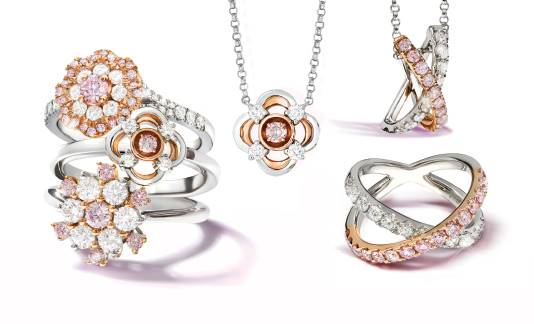 |
| Above: Blush Pink Diamonds |
International jewellers John Calleija and John Glajz have been licensed as Icon Partner and granted exclusive rights to develop the remaining Argyle pinks into jewellery and limited edition pieces.
Rio Tinto’s Coppens echoed the sentiment of Kaufman and said the pink diamond market requires careful management to preserve and continue the legacy of custody that underscores its rarity.
“This is a new chapter for Argyle pink diamonds and we are looking forward to many initiatives to ensure they maintain their value and investment potential as a finite, unrepeatable Australian natural treasure,” he says.
He adds that, following the launch of the Icon Partner program, “there has been considerable relief that Rio Tinto continues to manage the Argyle pink diamonds brand.
The importance of managing the Argyle pink diamonds brand came into sharp focus following the transition to the closure of the Argyle Diamond Mine.
“There are many instances of external parties who have proceeded with opportunistic initiatives that claim proprietary knowledge of Argyle pink diamonds brand, access to or affiliation with our business and ‘passing off’ trademarks and proprietary marketing materials.”
Market research
Rio Tinto has previously estimated Argyle pink diamond prices have appreciated by 500 per cent over the past two decades. Overall pink prices rose 116 per cent between 2009 and 2019, according to the Fancy Color Research Foundation (FCRF).
Based in New York, the FCRF offers quarterly insight into the international trade of fancy colour diamonds.
The FCRF recently released data for the second quarter of 2022, outlining a 0.8 per cent rise in pink diamond sales.
That sales performance was championed by the fancy vivid subsection, which rose 1.5 per cent, while the fancy vivid 10-carat and fancy 2-carat subsection both rose by 0.9 per cent.
The biggest increase over the past 12 months came from the fancy 5-carat category, rising by 6.3 per cent. The only significant decrease identified came from the fancy 8-carat category, down 1.3 per cent.
Fancy vivids across all colour categories showed an increase of 1 per cent for the second quarter, with a rise of 2.6 per cent over the past 12 months.
“It is evident that the increase in prices is driven by two market forces that haven’t occurred simultaneously in quite some time,” FCRF board member Ishaia Gol explains.
“That is, high demand for fancy-colour diamonds on the retail side, and fierce competition on rough in tenders.”
Knowledge is power
It’s been said that in order to move forward, we must first go back.
It’s a sentiment that’s been applied to a range of literary contexts and as of 2022, is a crucial idea that applies to the world of pink diamonds.
Consumers increasingly seek a deeper historical understanding of the path taken by a diamond, from deep within the core of the Earth to embedded within the framework of a ring, necklace or earrings.
Suppliers and retailers alike must therefore answer this call for knowledge in order to maintain the prestige of pink diamonds as a category and continue to capture the public’s attention and imagination with the innate beauty of said gemstones.
Read eMag